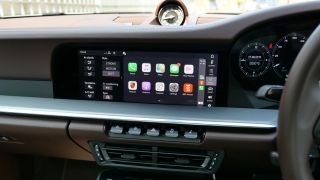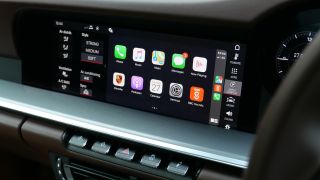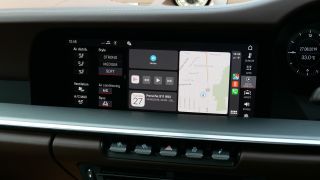Apple CarPlay: everything you need to know

In just a few short years, Apple has taken CarPlay from a rarely-seen optional extra with limited uses, to a must-have for any new car buyer. At its simplest, CarPlay takes the user interface and apps of your iPhone, and puts them on the dashboard display of your car.
Completely replacing your car’s own infotainment system (thats information and entertainment, btw), CarPlay brings with it some of the apps you are used to using, like maps (Apple, Google or Waze), music (Apple, Spotify and others), Messages, WhatsApp, Phone, Podcasts and more.
For its most recent upgrade with iOS 13, Apple has taken things even further. Now, car manufacturers are invited to put a CarPlay interface on more than one display. As cars start to feature multiple screens, this makes a lot of sense as it means CarPlay can appear on the central display and on digital instrument clusters behind the steering wheel.
There’s a lot to like about CarPlay, but it isn’t quite perfect just yet. Some manufacturers have started charging subscription fees for the service (which seems a bit mean, given the software is running on your phone, not the car), and not all apps are available. Read out to learn more about exactly what Apple CarPlay is, how it works, and how you can get it for yourself.
?What is CarPlay
In simple terms, CarPlay takes the user interface of your iPhone and puts it onto the infotainment screen of your car dashboard.
This means when your iPhone is plugged in, the car’s own system is replaced by the iOS home screen, complete with app icons and a virtual home button. New with iOS 13 is a new home screen, which sits to the left of the usual app launcher. Swipe over to this new screen, and you can see the map and media playback controls at the same time, plus a couple of app icons and other shortcuts. Exactly what’s shown on this screen depends on how you are using CarPlay, and the size of your car’s display.
CarPlay is interacted with via whatever controls your car already has, whether that be a touch screen, buttons, knobs, voice or a combination of all of these.
CarPlay doesn’t include every app on your smartphone, because playing Fortnight on your car dashboard is clearly a disaster waiting to happen, and some elements of apps are replaced by voice and dictation.
For example, incoming iMessages and WhatsApp messages are read out to you by Siri instead of being shown on the display.
Most cars require you to plug your iPhone into the USB port with a Lightning cable, but some newer models now support wireless CarPlay, which works via the car’s Bluetooth connection.
This is more convenient, but you’ll want to make sure your iPhone is sat on a wireless charger if using wireless CarPlay, as it can drain the battery quickly if you’re streaming music over 4G and using the Maps app for navigation. Thankfully, wireless charging is also becoming more common in pricier vehicles.
CarPlay is designed to remove the urge to take a quick look at your iPhone behind the wheel. It’s safer, easier and more convenient - or that’s the idea, anyway.

?Which cars support Apple CarPlay
As of October 2019, there are over 500 models of car with CarPlay available either standard or as a paid-for optional extra.
Some cars bundle CarPlay when you opt for the enhanced sound system, for example, or pick a higher level of cabin trim level.
Other manufacturers charge a premium for adding CarPlay on its own, and the price can vary significantly.
For example, Honda includes CarPlay as standard on some models, Mercedes charges £267 (about $330, AU$480), and Ford includes CarPlay with its circa £550 (about $680 / AU$1,000) Sync 3 system in the new Fiesta – along with a larger touch screen and the company’s own navigation system.
At the other end of the scale, Ferrari charges a huge £2,400 (about $2,900 / AU$4,400) for adding the software necessary to make it work.
Some manufacturers, like Mazda, allow for CarPlay to be retrofitted to some second-hand cars. For example, the company charges £350 (about $450, AU$650) to fit CarPlay to its current ND-generation MX-5. Alternatively, drivers handy with a screwdriver can buy the parts and fit it themselves for half that.
Finally on the topic of cost, some manufacturers like BMW are starting to charge an annual subscription for CarPlay after the first 12 months. BMW charges $80 / £85 / AU$179 per year, or new buyers can pay $300 / £295 (about AU$450) for a 20-year subscription which stays attached to the car.
We've included a list of manufacturers currently offering CarPlay at the end of this article. Although it doesn’t include everyone just yet, you’ll be doing well to name a car maker off the top of your head that doesn’t offer CarPlay – apart from Tesla, of course.
?Apple CarPlay aftermarket solutions
If you’re not in the market for a new car, you can still get some CarPlay in your life by installing an aftermarket stereo.
Manufacturers like Alpine, Clarion, JBL, JVC, Kenwood, Pioneer and Sony all sell car stereo systems with CarPlay, as well as other goodies like Android Auto, Bluetooth and DAB digital radio.
Prices start at around £200 (about $280 / AU$360) for an entry-level unit from a company like Power Acoustik, and go beyond £500 (about $700 / AU$900) for a fold-out system from Pioneer.
What you need to know about these systems is that car stereos come in two sizes; single DIN and double DIN. Single DIN units are usually two inches tall, while double DIN means a system which is four inches tall.
The former, like the Pioneer AVH-Z7000DAB we referred to above, is a single DIN unit with a motorised screen which folds out of your dashboard. Modern cars with their curved dashboards tend to not cater for aftermarket stereos like these without modification to the dashboard – something that's generally not advisable on most modern vehicles. In short, the older the car, the more likely you can retro-fit CarPlay with a third-party stereo.
?Is my iPhone compatible with CarPlay
If you’re still rocking an old iPhone with a 30-pin connector, then you’re out of luck; any model before the iPhone 5 does not work with CarPlay. No model of iPad or iPod Touch works with CarPlay.
But this also means a lot of iPhones do – and here they are:
- iPhone 5
- iPhone 5S
- iPhone 5C
- iPhone SE
- iPhone 6
- iPhone 6 Plus
- iPhone 6S
- iPhone 6S Plus
- iPhone 7
- iPhone 7 Plus
- iPhone 8
- iPhone 8 Plus
- iPhone X
- iPhone XS
- iPhone XS Max
- iPhone XR
- iPhone 11
- iPhone 11 Pro
- iPhone 11 Pro Max
?What does CarPlay look like
CarPlay is designed to look a lot like iOS. Sure, the home screen background is made black and most of your apps are hidden from view, but CarPlay is still the bare bones of your iPhone.
The main screen shows a selection of apps like Phone, Music, Maps and Messages, along with the time, your phone’s signal strength, and a virtual home button.
New for iOS 13, a second home screen sits to the left. This shows a map, plus a couple of shortcuts, media controls, and the icons of your most recently used apps. It’s a more useful and functional home screen than the app launcher page, but there are some limitations.
For example, the map widget on this age only shows navigation instructions if you’re using Apple Maps for directions. Use Google Maps and you’ll still hear the instructions, but nothing happens on the home screen. Instead, you’ll have to open Google Maps full-screen and stick with it.
Thankfully, third-party audio apps like Spotify and Audible do appear on the new dashboard screen. The layout of this new home screen depends on the size of your car’s main display.

Also new with iOS 13, which landed in September 2019, is a dark mode which switches on automatically at night to make the interface less distracting. Siri is also less visually distracting now, taking up just a small sliver at the foot of the screen instead of taking over the entire display when summoned.
Finally for the iOS 13 changes, there’s a new Calendar app. This gives you a simple look at your upcoming schedule for the day, and tapping on an event gives you the option to navigate to it using CarPlay, or call one of the attendees - presumably to say you’re running late, again.
As you open and close apps, the most recent three appear at the side of the user interface nearest the steering wheel, making it easy to return to the map, for example, without taking your eyes off the road for more than a quick glance.
That really is the point of CarPlay; it offers access to your iPhone’s core features without distracting you from driving.
That’s why most apps are hidden, and why many employ Siri to read things out rather than letting you read them off the screen.
For example, open the Messages app and you’ll see a list of the most recent people to chat with you, but when you tap on a name Siri reads out any unread messages, or asks if you’d like to dictate a reply.
Notifications appear at the top of the screen as they do on your iPhone, but these are limited to apps which can be used by CarPlay. If your phone receives a breaking news alert from the BBC, for example, it won’t show up and you won’t hear it either.
CarPlay also employs several tricks to make you spend less time looking at it. If you scroll through the artists list in your Music app, the interface will start showing large letters instead of every artist. Scroll until you get to the right letter, then pick the artist you want.
The home screen also shows an app to tap on if you want to return to the car’s own infotainment system.
To adjust the layout of apps on CarPlay you have to head into the Settings app on your iPhone itself (when it isn’t connected to the car).
Tap General, then CarPlay, then the car you want to change the home page of, and move the apps around as you would on the home screen of the phone itself.
Here is a selection of the top third-party apps that are compatible with CarPlay:
- Spotify
- BBC Sounds
- Amazon Music
- Google Play Music
- iPlayer Radio
- CBS Radio
- Pandora
- Slacker Radio
- Tidal
- Audible
- NPR One
- VOX
- Clammr
- Downcast
- Google Maps
- Waze
- Here
CarPlay used to be quite limited with regard to which third-party apps you could use, but as you can see from the list above, that situation has changed. Now you can use Google Maps, Spotify, BBC Sounds and WhatsApp instead of Apple’s equivalents.
Default iPhone apps on CarPlay:
- Phone
- Calendar
- Music
- Maps
- Messages
- Now Playing
- Podcasts
- Audiobooks

Comments
Post a Comment